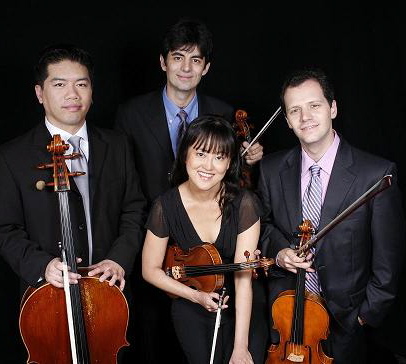Avalon Quartet launches Bartok cycle in fine style
Dmitri Shostakovich’s fifteen string quartets are often regarded as the greatest 20th-century achievement in the genre. But an equally if not more compelling case can be made for the string quartets of Bela Bartok.
While fewer in number at six, the Hungarian composer’s quartets are nearly as personal as those of Shostakovich. Yet they reflect not only Bartok’s own musical development but that of the larger roiling canvas of 20th-century music, which, in turn, his quartets impacted to a great extent.
The Avalon String Quartet launched its season-long survey of the Bartok quartets Sunday afternoon at the Art Institute’s Fullerton Hall. Beginning with No. 1, the ensemble will present the Bartok quartets in chronological order in their downtown series through March.
Completed in 1909, Bartok’s First Quartet bridges past and present in three connected movements. The opening descends from the chromatic late romanticism of Schoenberg’s Verklarte Nacht, with dirge-like music thought to reflect Bartok’s melancholy emotions after the end of the composer’s turbulent romantic liaison with the violinist Stefi Geyer. The ensuing movements are each faster than the preceding sections, incorporating Bartok’s folk elements and more angular style to come, the acceleration reflecting renewed energy and creative confidence after his post-Geyer desuetude.
Known for Classical elegance and pure, refined tone, the Avalon Quartet isn’t the first ensemble would think of as a natural fit for Bartok’s punchy, acidic style. Still the Avalon members (violinists Blaise Magniere and Marie Wang, violist Anthony Devroye and cellist Chen-Hou Lee) conveyed the dark, searching expression of the canonic opening bars effectively, segueing into the growing impassioned pages with ardor and concentrated playing.
At times one wanted greater bite and intensity from the leader Magniere, whose aristocratic style sometimes seemed too soft-focus for this music. Cellist Lee’s blend of tonal refinement and aggressive edge found the most idiomatic interpretive ground.
The performance took on greater assurance and cohesion as it continued, the complex rhythmic impetus and stamping accents gaining in cumulative intensity with a whirlwind coda. A fine launch to an important series, and one in which the Avalon players will likely find even stronger footing as their Bartok cycle unfolds.
The afternoon began with Mendelssohn’s Quartet in A minor, Op. 13.
The program title, “Beyond Beethoven” was more on point here, as the 18-year-old composer paid direct homage to his great predecessor with this 1827 work, written the year Beethoven died.
Mendelssohn’s precocious artistic maturity is nearly as astounding here as in his Octet or Midsummer Night’s Dream Overture, the composer fluently melding his own burgeoning voice with Beethoven’s stormy style.
The Avalon Quartet’s warm yet blended tone sounded strikingly rich and burnished in the introduction, the ensuing Allegro spirited and dynamic. The Adagio provided the highlight of the afternoon, beautifully played and plumbing a deep vein of elegiac feeling in the teenage Mendelssohn’s tribute to the late Beethoven.
The players also brought out the quaint folk-like feeling of the ensuing Allegretto. The rather literal account of the trio section could have used more charm and a lighter touch, though the finale held drama and refinement in a dexterous balance, with impassioned playing that kept within stylistic parameters.
Part of the unique presentation of the Avalon Quartet’s Art Institute series, now in its third season, is a prefatory slide presentation by Kathleen Burnett, interim creative director of lectures and performance programs at the museum. If the connection between the music of Bartok and Mendelssohn and the slides of Picasso and the Classical influence was rather tenuous, Burnett’s commentary was consistently informed and illuminating.
While the lectures are concentrated on the Art Institute’s own holdings, the arc and significance of Bartok’s quartets offers a broad opportunity for artistic parallels. Perhaps future lectures in the series could touch on, say, Kokoschka and more Hungarian and mid-European artists of the 20th century.
The Avalon String Quartet performs Bartok’s String Quartet No. 2 and Dvorak’s Quartet No. 14 in A flat Major, Op 105, 2 p.m. October 20 at Fullerton Hall. Admission is free to Art Institute members and museum visitors. artic.edu
The Bartok cycle will also be presented at Northern Illinois University in DeKalb, where the group is quartet in residence. avalonquartet.com
Posted in Performances





